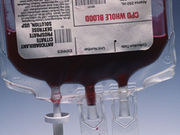NEC risk not increased for RBC-transfused very low-birth-weight infants versus nontransfused
TUESDAY, March 1, 2016 (HealthDay News) — Severe anemia, but not red blood cell (RBC) transfusion, is associated with increased risk of necrotizing enterocolitis (NEC) in very low-birth-weight (VLBW) infants, according to research published in the March 1 issue of the Journal of the American Medical Association.
Ravi M. Patel, M.D., of the Emory University School of Medicine in Atlanta, and colleagues evaluated data for 598 VLBW infants (≤1,500 g) enrolled in a secondary, prospective, multicenter observational cohort study. The association between RBC transfusion, severe anemia, and NEC was assessed.
The researchers found that 44 infants (7.4 percent) developed NEC, and 319 infants (53 percent) received RBC transfusions. In the unadjusted analysis, the cumulative incidence of NEC at week eight among RBC-transfused infants was 9.9 percent, compared to 4.6 percent among nontransfused infants. In multivariable analysis, RBC transfusion in a given week was not significantly associated with the rate of NEC (adjusted cause-specific hazard ratio, 0.44; 95 percent confidence interval, 0.17 to 1.12; P = 0.09). The rate of NEC among VLBW infants with severe anemia in a given week, compared with those who did not have severe anemia, was significantly increased (adjusted cause-specific hazard ratio, 5.99; 95 percent confidence interval, 2.00 to 18.0; P = 0.001).
“Among VLBW infants, severe anemia, but not RBC transfusion, was associated with an increased risk of NEC,” the authors write. “Further studies are needed to evaluate whether preventing severe anemia is more important than minimizing RBC transfusion.”
Copyright © 2016 HealthDay. All rights reserved.








